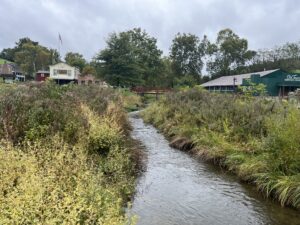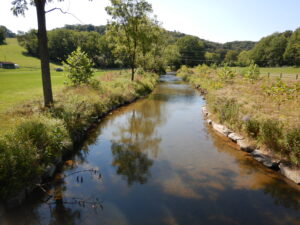GreenVest wrapped up the third year of maintenance and monitoring of the Muddy Creek (River Valley Ranch) Stream Restoration Project (MCRP) in 2022. This installment provides an update on the continued success of the restoration as we enter Year 4. First, a little background on the project.

Streams within the project area are known brook trout habitat, including Gunpowder Falls, Muddy Creek, and an unnamed tributary, referred to as the Roller Road Tributary. These waters connect to a broader network of native brook trout streams in the Upper Gunpowder Watershed. Prior to restoration, the stream channels were actively eroding, and in-stream habitat was continuing to degrade, threatened by sedimentation from bank erosion and a narrow or non-existent riparian buffer. In several stream reaches, there was limited floodplain connectivity, meaning the streams could not access their floodplains except during severe storm events. Additionally, these storm events wrought frequent flooding and pointed episodic erosion threatening nearby infrastructure. Most of the riparian zones within the project area were narrow or consisted of turf grass or pasture, instead of mature trees, and thus offered little to no function or value. Trees along streams help to prevent bank erosion, filter nutrients, and regulate surface water temperatures. Maintaining cooler water temperatures is particularly important for native brook trout in the area as they are susceptible to thermal pollution; increasing water temperatures lead to decreased levels of dissolved oxygen and other negative impacts to cold water aquatic life. Additionally, prior to restoration livestock had unrestricted access to multiple stream reaches which caused further instabilities and water quality degradation.
The MCRP was constructed in 2019 and 2020 to assist MDOT SHA – Maryland Department of Transportation State Highway Administration with their commitment to meet requirements of the Chesapeake Bay Total Maximum Daily Load (TMDL). This project helped to achieve objectives outlined in the local Watershed Implementation Plan (WIP). The stream restoration is located on private property in Carroll County, Maryland that is part of River Valley Ranch (RVR), a facility with broad reaching educational programming for youth and adults that offers a summer camp, outdoor education center, and seasonal events. The project garnered excitement from state and federal resource agencies and local conservation organizations because of the presence of native brook trout and a rare species.
Project permits require a full suite of monitoring to assess several aspects of the project including floodplain connectivity, stream bank stability, vegetative composition and structure, the functionality of restoration structures, in-stream habitat, and wetlands.

The site continues to perform well beyond expectations, and the restoration represents a successful example of how thoughtful restoration can recalibrate system function and set the stage for “rewilding” of aquatic species habitats. The restoration also enhanced the habitat of existing populations of native species of trout and rare species of reptile. The project has reconnected the streams to their floodplains, as demonstrated by more stable banks and measured hydraulic connections. This means that the streams can now flow onto their floodplains more frequently than before restoration, which reduces in-stream energies and erosion, facilitating natural patterns of sediment deposition and nutrient cycling. Anecdotally, RVR staff have mentioned to GreenVest that their main campus experiences less flooding and bank erosion now than prior to project construction. An assessment of all restoration structures and stream channels found the site to be functioning as designed, with improved stream bank stability transforming the natural resiliency of the ecosystem.
Additional monitoring metrics include habitat assessments, which are conducted in each restored stream reach. Our findings show that the restoration has improved the variety and availability of stable in-stream habitats for macroinvertebrates (aquatic insects) and fish, including those beneficial to the native brook trout population in the area. Some of these habitats include submerged logs, snags, cobble, in-stream vegetation, and undercut banks. In addition, riparian buffer and wetland assessments documented additional aquatic habitat created or enhanced by the project. Native vegetation planted for the project is maturing, including species of herbaceous vegetation, shrubs, and trees. Wetlands that were created by the project are functioning as wetlands after only three growing seasons, providing additional habitat function and value. To top it all off, the variety of plants in bloom for much of the growing season provides pollinator habitat with aesthetics being a positive co-benefit. RVR staff have mentioned to GreenVest that the beautiful blooms in the riparian buffer have been a popular backdrop for local photographers. The timelapse embedded here shows the transformative process of the project and the joy provided by the restored conditions.
Importantly, River Valley Ranch has been pleased with the project at each step along the way. Jon Bisset, President of Peter & John Ministries, which owns RVR, said:
“When we first approached GreenVest with our project, we knew it would be a tall order. We are a camp and retreat center that serves over 12,000 people per year with 2 rivers flowing through the middle of the property. Our goal was not only to stabilize our ever-eroding streams, but to do so in a way that would not affect the aesthetics of our park-like campus. GreenVest worked with us to creatively achieve both solutions, and we have been very pleased with the results. In addition, GreenVest had to perform the bulk of the work during our busiest season of the year (summer). They were very respectful of our guest policies, and restricted their work to areas that did not affect our guests or program. We would highly recommend GreenVest for their creativity, plan execution, and general ease with whom to work.”
It has been a pleasure working with RVR and project partners including Biohabitats, EQR, and Coastal Resources, Inc., to create a successful stream restoration project that enhances habitat for brook trout and a rare species. GreenVest’s core mission includes increasing community resilience through the implementation of nature-based solutions, like the work completed at the MCRP. GreenVest provided resiliency to a degraded system at an education facility through ecological uplift, resulting in decreased flooding risk and increased educational opportunities.



